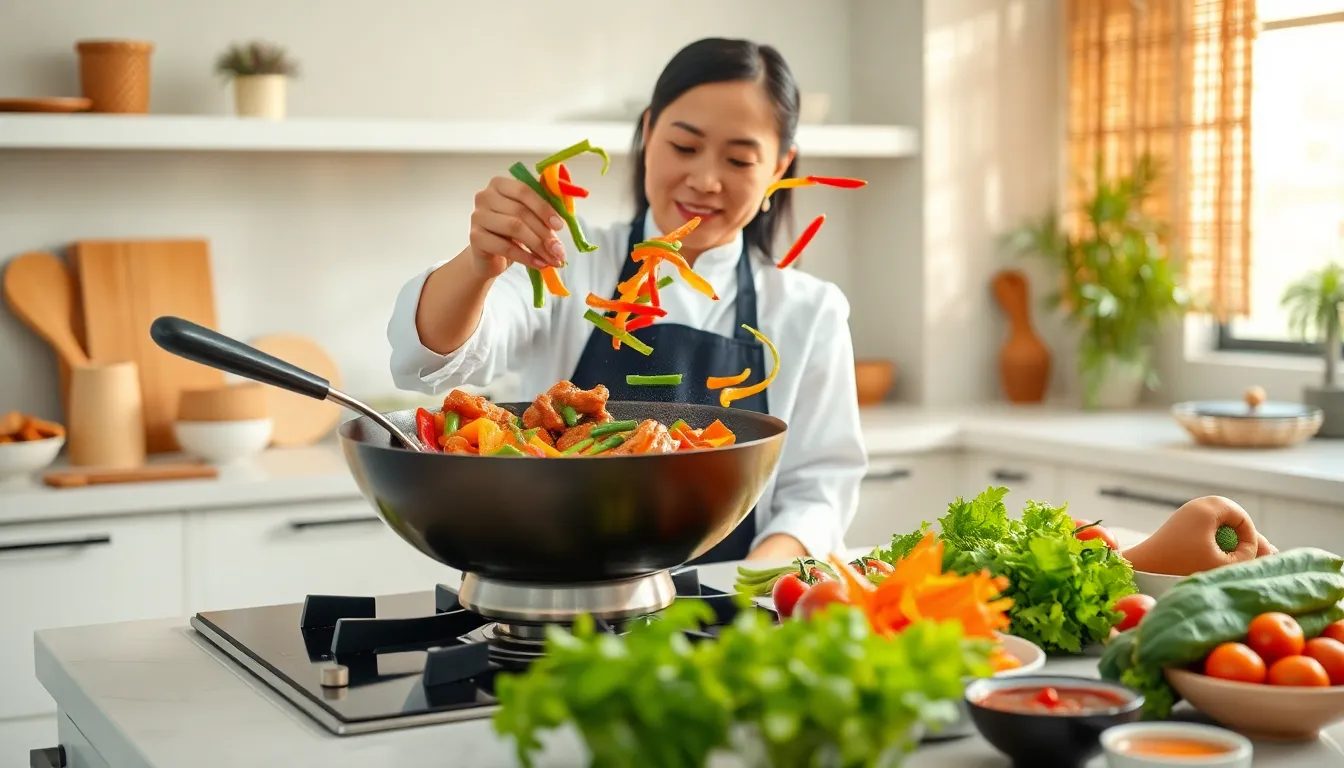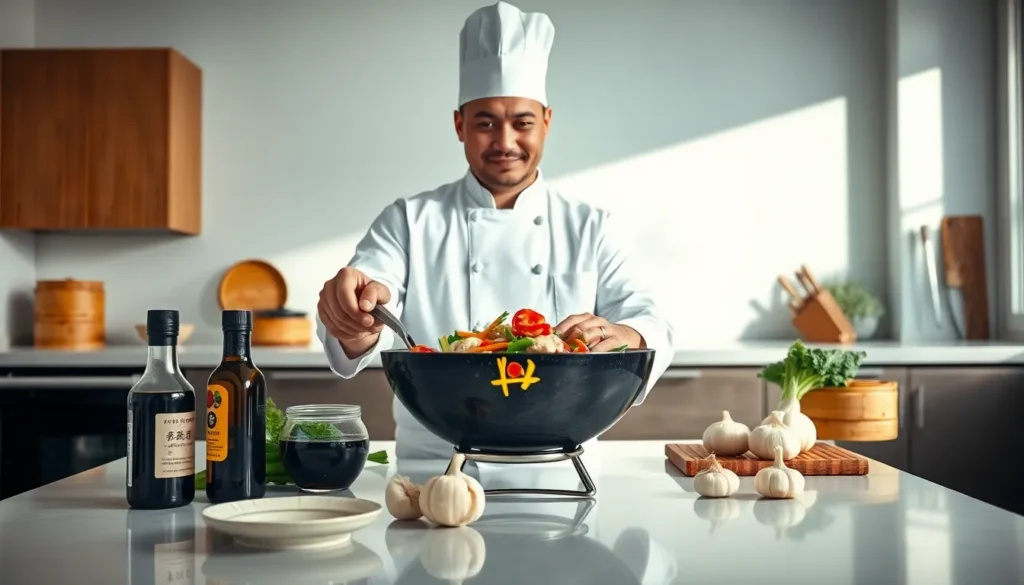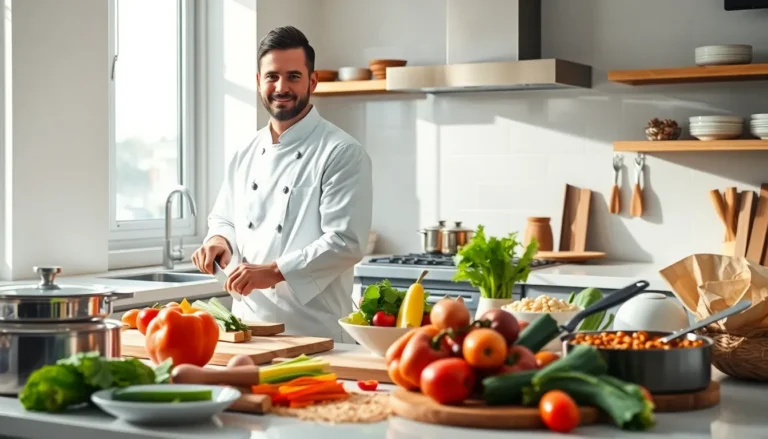Table of Contents
ToggleEver tried to replicate that delightful meal you had at your favorite Chinese restaurant, only to end up with a sad plate of beige mush? Fear not. Chinese cooking is an art form that, while intricate, can be mastered with some understanding of techniques and flavors. In this guide, we’ll unravel the magic behind Chinese cooking techniques to help you sizzle and steam your way to culinary success. Get ready to impress your friends, family, and taste buds.
Overview of Chinese Cooking

Chinese cooking is a treasure trove of techniques and flavors that reflect its rich history and regional diversity. This culinary tradition has evolved over thousands of years, influenced by geography, culture, and local ingredients. Understanding the fundamentals is essential for anyone looking to jump into this vibrant world of flavors.
At its core, Chinese cooking emphasizes balance. It’s all about harmonizing contrasting ingredients, sweet and savory, crunchy and soft, resulting in dishes that satisfy all the senses. In this culinary journey, everything matters, from the chopping of vegetables to the timing of when to add sauces.
So, buckle up. This delightful exploration will lead you through the various techniques that make Chinese cooking shine.
Understanding Flavor Profiles
No discussion on Chinese cooking is complete without a deep jump into its unique flavor profiles. The Chinese palate embraces a balanced symphony of flavors, often categorized into five primary profiles: sweet, sour, salty, bitter, and umami. Each region in China utilizes these tastes differently, creating a stunning array of dishes.
Sweet and Savory
In Cantonese cuisine, the blend of sweet and savory often shines through. Think sweet and sour pork or honey garlic chicken, flavors that dance and complement each other without overpowering the palate.
Biting Heat and Spice
On the other hand, Szechuan cooking brings the heat, literally. With an emphasis on bold flavors and spicy profiles, Szechuan dishes often incorporate ingredients like chili peppers and Szechuan peppercorns, offering a unique numbing sensation.
Fresh and Light
Hunan cuisine tends to favor fresh, vibrant ingredients and a hearty amount of chili, creating fresh and lively dishes that feel light yet satisfying. No matter the dish, understanding these flavors lays the groundwork for successful Chinese cooking.
Essential Cooking Techniques
Mastering Chinese cooking techniques is akin to being a seasoned chef, only you don’t have to be a chef to create delicious meals at home. Here are some essential techniques that will elevate any home cook’s repertoire.
Stir-Frying
This fast-paced technique is a cornerstone of Chinese cuisine. Utilizing a wok, stir-frying allows quick cooking at high heat, locking in flavors while leaving the vegetables crispy. The secret lies in prepping ingredients before heating the wok.
Steaming
A healthier cooking method, steaming preserves the natural flavors and nutrients of ingredients. It’s particularly common for dumplings or fish, making for lightweight yet flavorful dishes.
Braising
Braising is a slow-cooking technique that melds flavors beautifully. By searing the meat and then simmering it in a flavorful broth, it transforms tougher cuts into tender, melt-in-your-mouth sensations.
Sautéing and Pan-Frying
Sautéing is similar to stir-frying but often involves lower heat and a bit more oil, while pan-frying provides a crispy exterior on various protein options. Both techniques yield delicious results.
Boiling and Poaching
For dishes like hot pots or soups, boiling and poaching are essential. These methods are crucial for extracting flavors and ensuring ingredients are cooked thoroughly.
Roasting and Baking
Chinese roasting techniques, especially for meats like Peking duck, yield crispy skin and tender meat. Baking can introduce delightful pastries like mooncakes into the mix as well.
Ingredients and Tools for Chinese Cooking
Equipped with knowledge of techniques, let’s jump into the ingredients and tools required to step your Chinese cooking game up a notch.
Common Ingredients Used
Chinese cuisine thrives on a variety of ingredients. Essential staples include soy sauce, rice vinegar, sesame oil, and oyster sauce. Fresh herbs like cilantro and scallions also play a critical role in flavoring.
Don’t forget the proteins. Whether it’s chicken, pork, beef, fish, or tofu, each adds a unique characteristic to dishes. Vegetables like bok choy, snap peas, and mushrooms are also prominent, adding color and crunch.
Essential Cooking Tools
A few key tools can make all the difference. A good wok is indispensable for stir-frying and steaming. A sharp knife is crucial for precise cutting, while a bamboo steamer allows for gentle cooking of delicate items. Other useful items include a rolling pin for dough, ladles for soups, and several types of cutting boards.
Regional Variations in Techniques
China’s vast geography gives rise to an incredible diversity of cooking techniques and flavors. Each region brings its unique spin, showcasing local ingredients and culinary traditions.
Cantonese Cooking Techniques
Known for its emphasis on preserving the natural flavors of ingredients, Cantonese cooking employs techniques like steaming and braising. Dim sum, a beloved Cantonese tradition, showcases how cooking can be turned into a delightful experience.
Szechuan Cooking Techniques
As mentioned earlier, Szechuan cooking shies away from the light touch, diving headfirst into bold flavors. Techniques employed here often involve frying spices for deeper flavor, creating dishes that range from flavorful stir-fries to aromatic hot pots.
Hunan Cooking Techniques
Hunan cooking is brimming with spicy flavors and uses techniques like smoking and pickling. Known for its boldness, Hunan cuisine often makes use of fresh, local ingredients, reflecting the region’s agricultural bounty.



